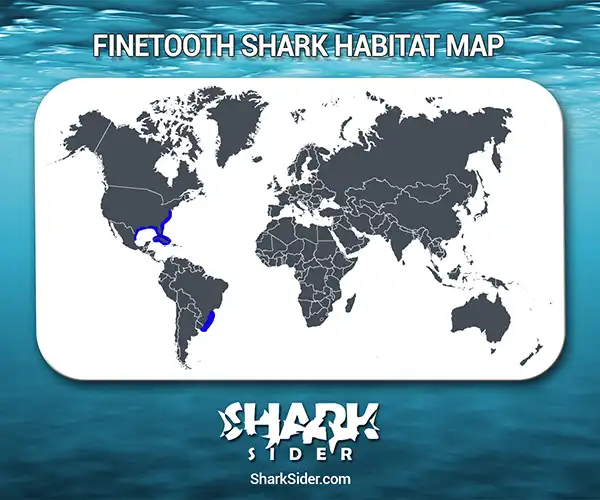The finetooth shark is a small, slender species belonging to the family Carcharhinidae or requiem sharks. It gets its name from the rows of sharp needle-like teeth.
Some other common names include night shark, eventooth shark, and smoothtooth shark.
Finetooth Shark Scientific Classification |
|
| Kingdom | Animalia |
| Phylum | Chordata |
| Class | Chondrichthyes |
| Order | Carcharhiniformes |
| Family | Carcharhinidae |
| Genus | Carcharhinus |
| Scientific Name | Carcharhinus isodon |
Description
The finetooth has a long pointed snout and a streamlined body. The average length that males grow up to is 5-7.4 ft, while the females reach 5.9-7.5 ft. The largest finetooth shark ever seen was 11.1 ft long.
The upper dorsal side of the shark is a shade of dark blue-gray transitioning to white ventrally. There is a presence of a pale white band along the body flank. The undersides of their pectoral fins are pure white.
Their mouths are round and broad towards the front consisting of some prominent labial furrows (layers of skin at the corners of the mouth).
They have five pairs of long gill slits along the base of the first dorsal fin, with the last two originating over the pectoral fin base.
Their head consists of large eyes with a nictitating membrane, and short and broad skin flaps cover the nares (nostrils of sharks).
The finetooth shark gets its name for its small, clear, fine teeth. 12 to 15 tooth rows occur on either side of the upper jaw and 13–14 tooth rows on either side of the lower. The upper teeth of these sharks are narrow and weakly serrated with erect oblique cusps. In contrast, the lower teeth are erect with transverse cusps that are neither rough nor have serrated edges.
There is a presence of small dermal denticles (tooth-like scales in the skin of the shark) that overlap each other. It consists of horizontal and sometimes slightly oblique ridges that lead to marginal teeth.
The first dorsal fin is small, triangular, with a pointed apex, and originates just below the pectoral fins. The second dorsal fin of these sharks is large with a small, pointed tip that arises over the anal fin. There is an absence of a ridge running between the dorsal fins.
The pectoral fins of these sharks are small and narrow with pointed tips, whereas their pelvic fins have narrowly rounded tips.
Where do they live
Map Of The Finetooth Shark’s Habitat

In North America, they have a wide range, extending from North Carolina, up to northern Gulf of Mexico, with some populations occasionally found as far as New York.
In the oceans of Central and South America, these sharks are found in Trinidad, Guyana, the Caribbean Sea, and south towards Cuba and southern Brazil (São Paulo to Santa Catarina).
They are commonly found close to beaches, estuaries, and even in bays. It inhabits increasingly shallow waters with a depth of 10m in summer, and 20m in winter.
Behavior
Dietary
During the daytime, the finetooth shark enters the surf zone to hunt for prey. They form schools consisting of adults and juveniles. The general diet of this species is bony fishes, the Atlantic menhaden(which the sharks swallowed whole after decapitating them), mullets, spot croakers, shrimps, and Spanish mackerels. The finetooth shark has also been caught scavenging on another shark that got caught accidentally during commercial fishing.
Reproductory
The mating ritual in finetooth sharks occurs from early May to June. To hold the female down for sexual intercourse, the males bite them. The male ejects its sperm cells which contain their genetic material and is stored in the female’s uterus.
The finetooth shark is viviparous: embryos develop by getting nourishment from the yolk for the initial 15 weeks. After this stage, the depleted and ruptured yolk sac transforms into a placental connection with the mother.
The gestation period lasts for about a year, after which the female gives birth to litters consisting 2-6 pups, each measuring 20-25 inches. They remain in shallow bays and coastal lagoons to protect themselves from predators.
The females live longer than the males but take a longer time to reach maturity. Males reach maturity at about 3.9 ft in length, and females mature at about 4.6 ft.
These sharks have been known to live up to fourteen years or above.
Migratory
The adult and juvenile finetooth sharks exhibit migratory behavior, particularly those inhabiting the northwestern Atlantic region. The juveniles and adults reach South Carolina between late March and early May when the water temperature increases to 68 °F. They stay there till September or mid of October and then travel to the southern parts of Florida as the water gets colder. However, the migratory behavior of shark populations in other regions is unknown.
Adaptations
Their slender and streamlined body shapes make them speedy swimmers and help them escape being caught by shrimp trawlers.
Interactions with humans
The finetooth shark is not harmful to humans. However, when captured, it reacts violently and often bites fishermen when not handled with caution.
Their meat is highly valued and is, therefore, an essential component of the fisheries of the southeastern United States. Other than that, these sharks have no other commercial importance. They are too fast to be caught by some shrimp trawlers and recreational fisheries but are sometimes captured by long lines and fishing boats using hook-and-lines.
The IUCN has categorized the finetooth shark as a ‘Near Threatened’ species in areas of the U.S, Mexico, and South America. Factors like low reproductive rate and habitat degradation make this shark vulnerable to overfishing.
